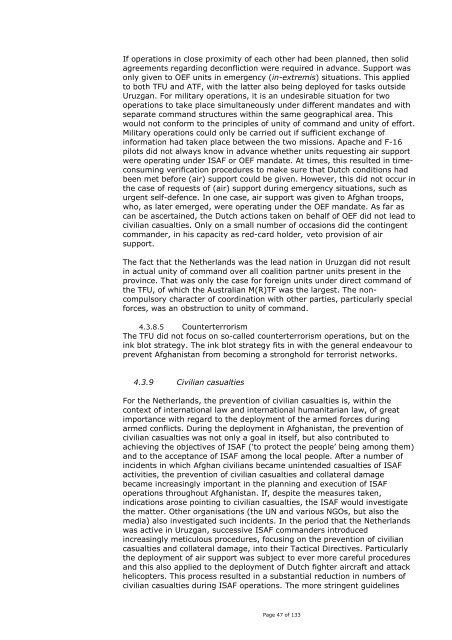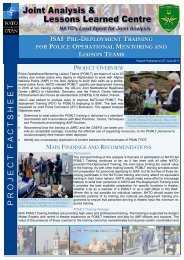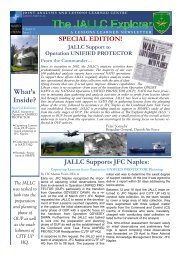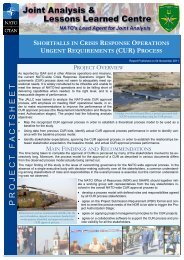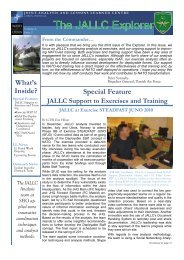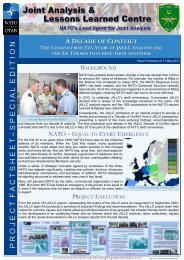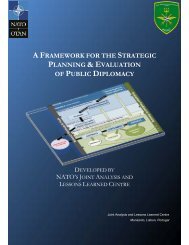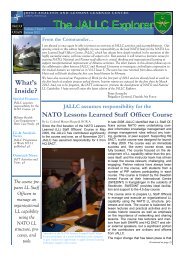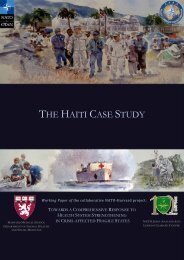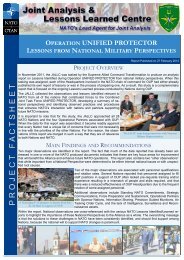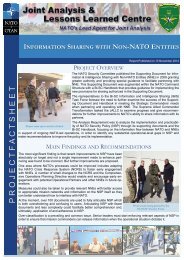4.3.8.2 International partnersFrom the time of the Dutch government’s decision <strong>in</strong> 2005, the <strong>Netherlands</strong>cooperated closely with Australia. At that time, Australian special units werealready active <strong>in</strong> Uruzgan. It was agreed with Australia that the <strong>Netherlands</strong>would be lead nation <strong>in</strong> Uruzgan and that the two countries would form acomb<strong>in</strong>ed task force under Dutch command. This task force was formallynamed the 1 st <strong>Netherlands</strong>/Australian Task Force Uruzgan(1(NLD/AUS)TFU), usually referred to as TFU. The Australian contributioncomprised a Reconstruction Task Force (RTF), later known as the Mentor<strong>in</strong>gand Reconstruction Task Force (MRTF) and f<strong>in</strong>ally as the Mentor<strong>in</strong>g TaskForce (MTF). Eventually, the M(R)TF encompassed six OMLTs work<strong>in</strong>g forthe benefit of the Afghan army. In addition to this contribution, Australiaalso based a special forces unit <strong>in</strong> (Task Force 66) <strong>in</strong> Uruzgan, which wasnot under TFU command. Both Dutch and Australian staff personnel workedon the TFU staff. TFU Dutch-Australian cooperation was later expanded to<strong>in</strong>clude France (one OMLT), the Czech Republic (guard personnel and PRTstaff members), Slovakia (guard personnel) and S<strong>in</strong>gapore (unmannedreconnaissance aircraft, medical personnel and surveillance radar).From 2008, the Dutch Air Task Force (ATF) worked closely with the BelgianF-16 detachment which was also based at Kandahar Airfield. Together withCanada, the <strong>Netherlands</strong> also formed the Canadian-Dutch Comb<strong>in</strong>ed AirBridge (CAB), which provided tactical air transport from the United ArabEmirates to Kandahar Airfield.4.3.8.3 Influence with<strong>in</strong> higher staffsDutch military officers assumed command of RC-S dur<strong>in</strong>g two separateperiods of the mission. The two officers <strong>in</strong> command, both of them <strong>in</strong> therank of major general, were supported by a small number of staff officers, astaff support company, a force protection platoon and an airmobile(reserve) company. Dutch military personnel also held important positions<strong>in</strong> the staffs of RC-S and <strong>ISAF</strong> <strong>in</strong> Kabul, Deputy Commander (Air) of <strong>ISAF</strong>and Deputy Chief of Staff Stability be<strong>in</strong>g among them. Directly responsibleto COM <strong>ISAF</strong>, the Dutch rear admiral <strong>in</strong> the latter position was responsiblefor, among other th<strong>in</strong>gs, the l<strong>in</strong>es of operation regard<strong>in</strong>g the governanceand development of Afghanistan and the organisation of the elections.Personnel for the mann<strong>in</strong>g of these staffs came from throughout the armedforces. Civilian positions <strong>in</strong> Kabul and Kandahar were also filled. Forexample, throughout the duration of the mission a senior political adviserwas posted to RC-S <strong>in</strong> Kandahar. These positions, and particularly that of C-RC-S, offered the possibility for the <strong>Netherlands</strong> to <strong>in</strong>fluence the course setby <strong>ISAF</strong> <strong>in</strong> general and activities <strong>in</strong> Uruzgan <strong>in</strong> particular. The Dutchcommanders held talks with, among others, the M<strong>in</strong>isters of Foreign Affairsand National Security Advisers of the United States, the United K<strong>in</strong>gdomand Canada and were subsequently able to clearly profile the <strong>Netherlands</strong>with<strong>in</strong> the context of the mission.4.3.8.4 OEF and <strong>ISAF</strong>In general, cooperation between OEF and <strong>ISAF</strong> units throughoutAfghanistan was transparent. For the Dutch troops <strong>in</strong> Uruzgan and for ATF,the Van Baalen motion of 24 November 2005 became an important factor.This motion called upon the Dutch government to, with<strong>in</strong> the context ofmissions, only cooperate with countries which respect <strong>in</strong>ternationalhumanitarian law and the Geneva Conventions; this <strong>in</strong>cluded operations aspart of the fight aga<strong>in</strong>st <strong>in</strong>ternational terrorism. On the basis of this motion,Dutch units could not work together with OEF units, ow<strong>in</strong>g to the postureadopted by the Bush adm<strong>in</strong>istration. No comb<strong>in</strong>ed operations were carriedout and, <strong>in</strong> pr<strong>in</strong>ciple, units did not operate <strong>in</strong> the same area simultaneously.Page 46 of 133
If operations <strong>in</strong> close proximity of each other had been planned, then solidagreements regard<strong>in</strong>g deconfliction were required <strong>in</strong> advance. Support wasonly given to OEF units <strong>in</strong> emergency (<strong>in</strong>-extremis) situations. This appliedto both TFU and ATF, with the latter also be<strong>in</strong>g deployed for tasks outsideUruzgan. For military operations, it is an undesirable situation for twooperations to take place simultaneously under different mandates and withseparate command structures with<strong>in</strong> the same geographical area. Thiswould not conform to the pr<strong>in</strong>ciples of unity of command and unity of effort.Military operations could only be carried out if sufficient exchange of<strong>in</strong>formation had taken place between the two missions. Apache and F-16pilots did not always know <strong>in</strong> advance whether units request<strong>in</strong>g air supportwere operat<strong>in</strong>g under <strong>ISAF</strong> or OEF mandate. At times, this resulted <strong>in</strong> timeconsum<strong>in</strong>gverification procedures to make sure that Dutch conditions hadbeen met before (air) support could be given. However, this did not occur <strong>in</strong>the case of requests of (air) support dur<strong>in</strong>g emergency situations, such asurgent self-defence. In one case, air support was given to Afghan troops,who, as later emerged, were operat<strong>in</strong>g under the OEF mandate. As far ascan be ascerta<strong>in</strong>ed, the Dutch actions taken on behalf of OEF did not lead tocivilian casualties. Only on a small number of occasions did the cont<strong>in</strong>gentcommander, <strong>in</strong> his capacity as red-card holder, veto provision of airsupport.The fact that the <strong>Netherlands</strong> was the lead nation <strong>in</strong> Uruzgan did not result<strong>in</strong> actual unity of command over all coalition partner units present <strong>in</strong> theprov<strong>in</strong>ce. That was only the case for foreign units under direct command ofthe TFU, of which the Australian M(R)TF was the largest. The noncompulsorycharacter of coord<strong>in</strong>ation with other parties, particularly specialforces, was an obstruction to unity of command.4.3.8.5 CounterterrorismThe TFU did not focus on so-called counterterrorism operations, but on the<strong>in</strong>k blot strategy. The <strong>in</strong>k blot strategy fits <strong>in</strong> with the general endeavour toprevent Afghanistan from becom<strong>in</strong>g a stronghold for terrorist networks.4.3.9 Civilian casualtiesFor the <strong>Netherlands</strong>, the prevention of civilian casualties is, with<strong>in</strong> thecontext of <strong>in</strong>ternational law and <strong>in</strong>ternational humanitarian law, of greatimportance with regard to the deployment of the armed forces dur<strong>in</strong>garmed conflicts. Dur<strong>in</strong>g the deployment <strong>in</strong> Afghanistan, the prevention ofcivilian casualties was not only a goal <strong>in</strong> itself, but also contributed toachiev<strong>in</strong>g the objectives of <strong>ISAF</strong> (‘to protect the people’ be<strong>in</strong>g among them)and to the acceptance of <strong>ISAF</strong> among the local people. After a number of<strong>in</strong>cidents <strong>in</strong> which Afghan civilians became un<strong>in</strong>tended casualties of <strong>ISAF</strong>activities, the prevention of civilian casualties and collateral damagebecame <strong>in</strong>creas<strong>in</strong>gly important <strong>in</strong> the plann<strong>in</strong>g and execution of <strong>ISAF</strong>operations throughout Afghanistan. If, despite the measures taken,<strong>in</strong>dications arose po<strong>in</strong>t<strong>in</strong>g to civilian casualties, the <strong>ISAF</strong> would <strong>in</strong>vestigatethe matter. Other organisations (the UN and various NGOs, but also themedia) also <strong>in</strong>vestigated such <strong>in</strong>cidents. In the period that the <strong>Netherlands</strong>was active <strong>in</strong> Uruzgan, successive <strong>ISAF</strong> commanders <strong>in</strong>troduced<strong>in</strong>creas<strong>in</strong>gly meticulous procedures, focus<strong>in</strong>g on the prevention of civiliancasualties and collateral damage, <strong>in</strong>to their Tactical Directives. Particularlythe deployment of air support was subject to ever more careful proceduresand this also applied to the deployment of Dutch fighter aircraft and attackhelicopters. This process resulted <strong>in</strong> a substantial reduction <strong>in</strong> numbers ofcivilian casualties dur<strong>in</strong>g <strong>ISAF</strong> operations. The more str<strong>in</strong>gent guidel<strong>in</strong>esPage 47 of 133
- Page 1 and 2: Final evaluationNetherlands contrib
- Page 3 and 4: High mountainsLow mountainsPlains a
- Page 5 and 6: Table of ContentsDutch military per
- Page 7 and 8: Dutch military personnel deceased i
- Page 9 and 10: Page 9 of 133
- Page 11 and 12: 1 IntroductionThe government would,
- Page 13 and 14: The structure of the final evaluati
- Page 15 and 16: 2 The international presence in Afg
- Page 17 and 18: insurgents in, particularly, the ea
- Page 19 and 20: 3 Netherlands policy for participat
- Page 21 and 22: Netherlands’ presence. Furthermor
- Page 23 and 24: “The objectives of this stabilisa
- Page 25 and 26: In December 2005, the Netherlands g
- Page 27 and 28: The expectation is that meaningful
- Page 29 and 30: 3.6.2 Implementation of national pr
- Page 31 and 32: 4 Implementation of the mission and
- Page 33 and 34: tasks to fulfil in the area of secu
- Page 35 and 36: such as the Bushmaster, that was be
- Page 37 and 38: Afghan partner unit, at all times o
- Page 39 and 40: northern part of Deh Rawod in 2007.
- Page 41 and 42: in large and small bases, while con
- Page 43 and 44: previously thought and comprised a
- Page 45: Apart from facilitating training an
- Page 49 and 50: As previously mentioned, the preven
- Page 51 and 52: - Between 2006 and 2010, the number
- Page 53 and 54: government of Chora in January 2010
- Page 55 and 56: At the beginning of the Dutch missi
- Page 57 and 58: intermediary of TLO and political a
- Page 59 and 60: interest for filling judicial posit
- Page 61 and 62: During the Uruzgan mission, a great
- Page 63 and 64: structurally change governance in U
- Page 65 and 66: development programmes. Before the
- Page 67 and 68: also the way in which Afghans perce
- Page 69 and 70: tailored to the real needs of the p
- Page 71 and 72: Gizab had increased and there was a
- Page 73 and 74: The DCU programme devoted and still
- Page 75 and 76: purpose of these loans, cooperative
- Page 77 and 78: In view of the lack of enthusiasm a
- Page 79 and 80: 5 Expenditure for the mission and i
- Page 81 and 82: Overview of long-term expenditure a
- Page 83 and 84: expenditure related to the deployme
- Page 85 and 86: Multi-year expenditure, Foreign Aff
- Page 87 and 88: explosive ordnance disposal, armour
- Page 89 and 90: this situation as constraining, for
- Page 91 and 92: organised at a later stage. In addi
- Page 93 and 94: occupational social workers and the
- Page 95 and 96: Mercedes Benz terrain vehicle, the
- Page 97 and 98:
6 ConclusionsThis chapter begins wi
- Page 99 and 100:
The first part of the central quest
- Page 101 and 102:
At the end of 2005, the Afghan auth
- Page 103 and 104:
province. This, too, was done by me
- Page 105 and 106:
area, increased sales of agricultur
- Page 107 and 108:
ISAF and the OEF led to extra coord
- Page 109 and 110:
d. The recommendations from advisor
- Page 111 and 112:
Page 111 of 133
- Page 113 and 114:
Annex A, Afghanistan Compact Benchm
- Page 115 and 116:
end-2010, reforms will strengthen t
- Page 117 and 118:
Afghan Cultural HeritageA comprehen
- Page 119 and 120:
Private Sector Development and Trad
- Page 121 and 122:
Annex B, Results of the socio-econo
- Page 123 and 124:
EducationTLO data:• In 2006 there
- Page 125 and 126:
Overview of the number of children
- Page 127 and 128:
Annex C, Chronology200522 December:
- Page 129 and 130:
July: microcredit provider World Co
- Page 131 and 132:
Annex D, List of abbreviations3DADZ
- Page 133:
Page 133 of 133


